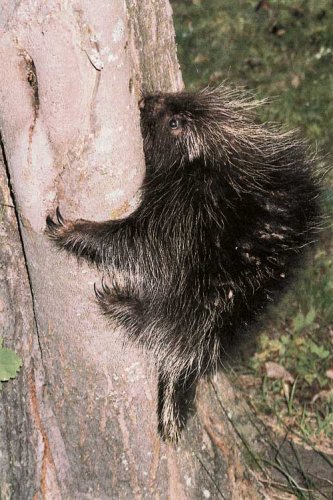A young porcupine came awkwardly waddling into my yard last summer, as if he owned the place. I walked out to meet him but he started moving toward a nearby tree. I caught him on film just as he began to slowly climb it.
Porcupines have no need to hurry. They have a formidable defense with their armor of dart-like quills, which give any predator a sharp reminder that this animal is no easy prey. An hour after porcupines are born, their quills become hardened and are ready for business. Few other babies in the wild are so well protected.
Porcupines cannot throw their quills. When attacked, they will take a defensive posture with their rump and tail, heavily loaded with needle sharp quills, toward the danger. They thrash their tails back and forth, and the quills easily become detached when they pierce the skin of the enemy. The tip of the quills can have tiny backward-pointing barbs that make their extraction painful, like removing a fish hook.
As the quills become embedded in the predator's flesh, they work their way deeper into its body. Some wild animals have been known to starve to death with their mouth and throat so full of porcupine quills, it was impossible for them to eat.
Predators need only one painful encounter with a porcupine to leave the entire porcupine clan alone. However, fishers and pumas have learned to flip the porcupine over and attack its quill-less belly.
Among the longest living rodents, porcupines can be very vocal, moaning, grunting, whining, wailing and clicking their teeth. They are good swimmers, with their hollow quills helping to keep them afloat. One porcupine can have as many as 30,000 quills. The ones lost can be replaced.
Nearsighted and clumsy, porcupines are strict vegetarians, with a diet of leaves and tree bark. They will climb trees and strip the bark from the upper most branches, often spending days in a single tree, invoking the wrath of foresters. During the winter they do not hibernate, but in bad weather they stay in their dens of hollow trees or rock crevices.
Each spring, the female porcupine has just one offspring, which at birth is about twice the weight of a newborn black bear. The porcupine's gestation period is almost the same as that of a moose, over 200 days.
Porcupine quill craft is an ancient Native American art found no where else in the world. When I attended the 18th annual Harvest Moon Festival at the Mount Kearsarge Indian Museum in Warner last fall, Rose Hartwell was using porcupine quills to decorate an otter pelt. She demonstrated how porcupine quills can be soaked in warm water, dyed various colors and woven into birch bark, fabric or leather to make creative designs. Quills sewn into deerskin were used as a trading wampum for Northeastern Native American tribes.
The quills, which to the porcupine are protective darts, have been used for thousands of years in decorative embroidery arts.









